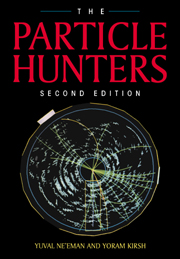Book contents
- Frontmatter
- Contents
- Preface to the first edition
- Preface to the second edition
- 1 The building blocks of the atom
- 2 Physical laws for small particles
- 3 The discoveries of the 1930s and 1940s
- 4 Particle accelerators — or from hunters to farmers
- 5 Strange particles
- 6 Basic forces and the classification of particles
- 7 Conservation laws
- 8 Short-lived particles
- 9 To the quarks — via the eightfold way
- 10 More quarks — or charm, truth and beauty
- 11 The Standard Model and beyond
- Appendix 1 Properties of semi-stable particles
- Appendix 2 The Greek alphabet
- Name index
- Subject index
1 - The building blocks of the atom
Published online by Cambridge University Press: 05 August 2012
- Frontmatter
- Contents
- Preface to the first edition
- Preface to the second edition
- 1 The building blocks of the atom
- 2 Physical laws for small particles
- 3 The discoveries of the 1930s and 1940s
- 4 Particle accelerators — or from hunters to farmers
- 5 Strange particles
- 6 Basic forces and the classification of particles
- 7 Conservation laws
- 8 Short-lived particles
- 9 To the quarks — via the eightfold way
- 10 More quarks — or charm, truth and beauty
- 11 The Standard Model and beyond
- Appendix 1 Properties of semi-stable particles
- Appendix 2 The Greek alphabet
- Name index
- Subject index
Summary
The beginnings of atomic research
The word ‘atom’ is derived from the Greek ‘atomos’, meaning indivisible. In about the year 400 BC the Greek philosopher Democritus postulated that all matter was made up of minute particles which could not be destroyed or broken up. He was unable to perform any experiment to support his hypothesis, but this concept could account for the fact that different substances had different densities: the more the atoms were compressed the denser and heavier the substance became. A few Greek sages accepted the atomic theory of Democritus, but the great majority adopted the view of Aristotle, who believed that matter was continuous in structure, and this was also the opinion held by the alchemists in the Middle Ages. When modern scientific research began in the seventeenth and eighteenth centuries, the concept of atoms was revived and appeared in the writings of scientists, but it was generally mentioned incidentally and no attempt was made to use it to explain natural phenomena or to verify it experimentally.
John Dalton is regarded as the father of modern atomic theory. He was an English teacher who dabbled in chemistry as a hobby and became one of the founders of modern chemistry.
- Type
- Chapter
- Information
- The Particle Hunters , pp. 1 - 27Publisher: Cambridge University PressPrint publication year: 1996



